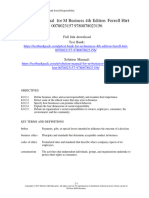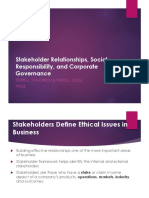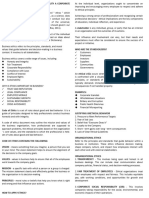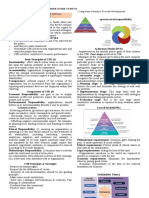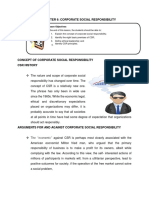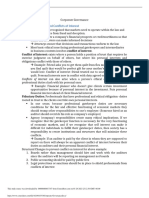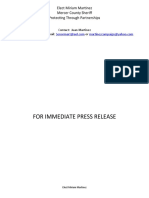Defining Business Ethics: Afterwork Assessment
Defining Business Ethics: Afterwork Assessment
Uploaded by
Pamela Rose CasenioCopyright:
Available Formats
Defining Business Ethics: Afterwork Assessment
Defining Business Ethics: Afterwork Assessment
Uploaded by
Pamela Rose CasenioOriginal Title
Copyright
Available Formats
Share this document
Did you find this document useful?
Is this content inappropriate?
Copyright:
Available Formats
Defining Business Ethics: Afterwork Assessment
Defining Business Ethics: Afterwork Assessment
Uploaded by
Pamela Rose CasenioCopyright:
Available Formats
Module 2
Defining Business
Ethics
1. Defining Business Ethics
2. Who are the Stakeholders?
3. An ethical crisis
4. Resolving ethical dilemma
5. Justifying unethical behavior
1. Defining Business Ethics: Afterwork Assessment
MODULE 2 – Defining Business Ethics 1|PAGE
The application of ethical standards to business behavior.
refers to implementing appropriate business policies and practices with regard to
arguably controversial subjects. Some issues that come up in a discussion of ethics
include corporate governance, insider trading, bribery, discrimination, social
responsibility, and fiduciary responsibilities.
Business ethics has two distinctive perspectives:
1. A descriptive summation of the customs,
attitudes, and rules that are observed within
a business. As such, we are simply
documenting what is happening.
2. A normative (or prescriptive) evaluation of
the degree to which the observed customs,
attitudes, and rules can be said to be ethical.
Here we are more interested in
recommending what should be happening. Source:https://s3.amazonaws.com/blog.v-comply.com/wp-
content/uploads/2018/04/24054956/vc-blog-ethics.jpg
Someone with a share or interest in a business enterprise.
A stakeholder is a party that has an interest in a company and can either affect or be
affected by the business. The primary stakeholders in a typical corporation are its
investors, employees, customers and suppliers.
Figure 2.1 maps out the relevant
stakeholders for any organization and their
respective interests in the ethical operation
of that organization. Note very stakeholder
will be relevant in every business situation
Of greater concern is the involvement of
these stakeholders with the actions of the
organization and the extent to which they
would be impacted by unethical behavior.
As Figure 2.2 illustrates, the decision of an
organization such as WorldCom to hide the
extensive debt and losses it was
accumulating in its aggressive pursuit of
Source: https://ideas.darden.virginia.edu/sites/default/files/2019- growth and market share can be seen to
08/201908_Stakeholder-Theory-Collection%404x.png have impacted all of its stakeholders in
different ways.
MODULE 2 – Defining Business Ethics 2|PAGE
MODULE 2 – Defining Business Ethics 3|PAGE
Source:https://diligent.com/en-gb/blog/uk-six-top-tips-effective-corporate-governance-framework/word-cloud-
corporate-governance/
Corporate Governance
The system by which business corporations are directed and controlled
Corporate governance is the structure of rules, practices, and processes used to direct
and manage a company. A company's board of directors is the primary force
influencing corporate governance.
The standard of corporate governance, the extent to which the officers of a corporation are
fulfilling the duties and responsibilities of their offices to the relevant stakeholders, appears to
be at the lowest level in business history:
Several prominent organizations have been found to have hidden the true state of their
precarious finances from their stakeholders.
Others have been found to have senior officers who appeared to regard the
organization’s funds as their personal bank accounts.
Financial reports are released that are then restated at a later date.
Products are rushed to market that have to be recalled due to safety problems at a later
date.
Organizations are being sued for monopolistic practices, race and gender
discrimination, and environmental contamination.
CEO salary increases far exceed those of the employees they lead.
CEO salaries have increased while shareholder returns have fallen
CEOs continue to receive bonuses while the stocks of their companies underperform
the market average and thousands of employees are being laid off.
MODULE 2 – Defining Business Ethics 4|PAGE
Oxymoron
The combination of two contradictory terms, such as “deafening silence” or “jumbo
shrimp.”
Code of Ethics
A company’s written standards of ethical
behavior that are designed to guide
managers and employees in making the
decisions and choices they face every day.
So, the code of ethics can be seen to serve a dual
function. As a message to the organization’s
stakeholders, the code should represent a clear
corporate commitment to the highest standards of
ethical behavior. As an internal document, the
code should represent a clear guide to managers
and employees in making the decisions and
Source:https://www.yourmembership.com/blog/code-ethics-important/
choices they face every day.
RESOLVING
ETHICAL
DILEMMAS
When employees observe unethical
behavior (for example, fraud, theft of
company property, or incentives being paid
under the table to suppliers or vendor
partners) or are asked to do something that
conflicts with their own personal values
Source:https://www.complianceweek.com/surveys-and- (selling customers products or services they
benchmarking/survey-with-ethical-dilemmas-aplenty-compliance-in-position- don’t need or that don’t fill their needs), the
to-lead/28690.article
extent of the guidance available to them is
often nothing more than a series of clichés:
Consult the company code of ethics
Do what’s right for the organization’s stakeholders.
Do what’s legal.
Do what you think is best (“use your best judgment”).
Do the right thing.
However, in many cases, the scenario the employee faces are not a clear-cut case of right and
wrong, but a case of right versus right. In this scenario, the ethical dilemma involves a situation
that requires selecting between conflicting values that are important to the employee or the
organization.
MODULE 2 – Defining Business Ethics 5|PAGE
RESOLUTION
Resolution of an ethical dilemma can be achieved by first recognizing the type of conflict you
are dealing with:
Truth versus loyalty. Do you tell the truth or remain loyal to the person or organization
that is asking you not to reveal that truth?
Short term versus long term. Does
your decision have a short-term
consequence or a longer-term
consequence?
Justice versus mercy. Do you
perceive this issue as a question of
dispensing justice or mercy?
(Which one are you more
comfortable with?)
Source:https://www.insperity.com/blog/conflict-resolution/
Individual versus community. Will
your choice affect one individual or
a wider group or community?
Once you have reached a decision as to the type of conflict you are facing, three resolution
principles are available to you:
Ends-based. Which decision would provide the greatest good for the greatest number
of people?
Rules-based. What would happen if everyone made the same decision as you?
The Golden Rule. Do unto others as you would have them do unto you.
None of these principles can be said to offer a perfect solution or resolution to the problem
since you cannot possibly predict the reactions of the other people involved in the scenario.
However, the process of resolution at least offers something more meaningful than “going with
your gut feeling” or “doing what’s right.”
JUSTIFYING UNETHICAL BEHAVIOR
So how do supposedly intelligent,
and presumably experienced,
executives and employees manage
to commit acts that end up
inflicting such harm on their
companies, colleagues, customers,
and vendor partners? Saul
Gellerman identified “four
commonly held rationalizations
that can lead to misconduct”:
Source: https://esmt.berlin/knowledge/dirty-dozen-how-unethical-behaviour-creeps-your-
organisation
MODULE 2 – Defining Business Ethics 6|PAGE
1. A belief that the activity is within reasonable ethical and legal limits—that is, that it is
not “really” illegal or immoral.
2. A belief that the activity is in the individual’s or the corporation’s best interests—that
the individual would somehow be expected to undertake the activity.
3. A belief that the activity is safe because it will never be found out or publicized—the
classic crime-and punishment issue of discovery.
4. A belief that because the activity helps the company, the company will condone it and
even protect the person who engages in it.
MODULE 2 – Defining Business Ethics 7|PAGE
Republic of the Philippines
CAPIZ STATE UNIVERSITY
PONTEVEDRA CAMPUS
Bailan, Pontevedra, Capiz
College of Management
Module 2: Worksheet 1 in BA 314
Defining Business Ethics: Afterwork assessment
1st Semester, A.Y. 2020-2021
Exercise
Name: Course/Yr./Sec.:
Directions: These questions are for student evaluation to determine if you have understood the
lessons discussed in the module. Answer the following questions below and put your answers
on the space provided.
1. Explain the term business ethics.
___________________________________________________________________________
___________________________________________________________________________
___________________________________________________________________________
___________________________________________________________________________
___________________________________________________________________________
2. Explain the difference between a descriptive and prescriptive approach to business
ethics.
___________________________________________________________________________
___________________________________________________________________________
___________________________________________________________________________
___________________________________________________________________________
___________________________________________________________________________
3. Give four examples of how stakeholders could be negatively impacted by unethical
corporate behavior.
___________________________________________________________________________
___________________________________________________________________________
___________________________________________________________________________
___________________________________________________________________________
___________________________________________________________________________
4. Define the term oxymoron and provide three examples.
___________________________________________________________________________
___________________________________________________________________________
___________________________________________________________________________
___________________________________________________________________________
___________________________________________________________________________
MODULE 2 – Defining Business Ethics 8|PAGE
5. Is the term business ethics an oxymoron? Explain your answer.
___________________________________________________________________________
___________________________________________________________________________
___________________________________________________________________________
___________________________________________________________________________
___________________________________________________________________________
6. Explain the term code of ethics.
___________________________________________________________________________
___________________________________________________________________________
___________________________________________________________________________
___________________________________________________________________________
___________________________________________________________________________
If you have any comments, suggestions, or recommendations on how will the subject teacher
improve the discussion please write them on the space below. Thank you! ☺
___________________________________________________________________________
___________________________________________________________________________
___________________________________________________________________________
___________________________________________________________________________
___________________________________________________________________________
MODULE 2 – Defining Business Ethics 9|PAGE
Republic of the Philippines
CAPIZ STATE UNIVERSITY
PONTEVEDRA CAMPUS
Bailan, Pontevedra, Capiz
College of Management
Module 2: Evaluation in BA 314
Defining Business Ethics: Short Case Study
1st Semester, A.Y. 2020-2021
Evaluation
Name: Course/Yr./Sec.:
Directions: Read the case study and analyze the situation carefully then answer the questions
related to the case study that was read. Write your answers on the space provided after the
questions.
BUSINESS TRIP: Short Case Study
You are returning from a business trip. As you wait in the departure lounge for your flight
to begin boarding, the gate personnel announce that the flight has been significantly
overbooked and that they are offering incentives for passengers to take later flights. After
several minutes, the offer is raised to a free round-trip ticket anywhere in the continental United
States plus meal vouchers for dinner while you wait for your later flight. You give the offer
serious consideration and realize that even though you’ll get home several hours later than
planned, the inconvenience will be minimal, so you give up your seat and take the free ticket
and meal vouchers.
1. Since you are traveling on company time, does the free ticket belong to you or your
company? Defend your choice.
___________________________________________________________________________
___________________________________________________________________________
___________________________________________________________________________
___________________________________________________________________________
___________________________________________________________________________
___________________________________________________________________________
2. If the later flight was actually the next day (and the airline offered you an
accommodation voucher along with the meal vouchers) and you would be late getting
into work, would you make the same choice? Explain your answer.
___________________________________________________________________________
___________________________________________________________________________
___________________________________________________________________________
___________________________________________________________________________
MODULE 2 – Defining Business Ethics 10 | P A G E
___________________________________________________________________________
___________________________________________________________________________
3. What if the offer only reached a $100 discount coupon on another ticket—would you
still take it? If so, would you hold the same opinion about whether the coupon belonged
to you or your company?
___________________________________________________________________________
___________________________________________________________________________
___________________________________________________________________________
___________________________________________________________________________
___________________________________________________________________________
___________________________________________________________________________
4. Should your company offer a clearly stated policy on this issue, or should it trust its
employees to “do the right thing”? Explain your answer.
___________________________________________________________________________
___________________________________________________________________________
___________________________________________________________________________
___________________________________________________________________________
___________________________________________________________________________
___________________________________________________________________________
MODULE 2 – Defining Business Ethics 11 | P A G E
Additional Readings and References
Additional Reading:
https://www.southuniversity.edu/news-and-blogs/2017/07/ethical-principles-for-
business-38725
https://berc.centerforethicsinpractice.org/importance-of-business-ethics/
https://managementhelp.org/businessethics/index.htm
References:
The Ethics and Compliance Officer Association, www.theecoa.org; The Ethics
Resource Center, www.ethics.org; and Society of Corporate Compliance and Ethics,
www.corporatecompliance.org.
ERC, “Creating a Workable Company Code of Ethics,” www.ethics.org, 2003.
Institute of Global Ethics, www.globalethics.org/bds/reading.html.
Saul W. Gellerman, “Why ‘Good’ Managers Make Bad Ethical Choices,” Harvard
Business Review, July–August 1986.
Image Sources:
https://corporatefinanceinstitute.com/resources/knowledge/other/business-ethics/
https://s3.amazonaws.com/blog.v-comply.com/wp-content/uploads/2018/04/24054956/vc-blog-
ethics.jpg
https://ideas.darden.virginia.edu/sites/default/files/2019-08/201908_Stakeholder-Theory-
Collection%404x.png
https://diligent.com/en-gb/blog/uk-six-top-tips-effective-corporate-governance-framework/word-
cloud-corporate-governance/
https://www.yourmembership.com/blog/code-ethics-important/
https://www.complianceweek.com/surveys-and-benchmarking/survey-with-ethical-dilemmas-aplenty-
compliance-in-position-to-lead/28690.article
https://www.complianceweek.com/surveys-and-benchmarking/survey-with-ethical-
dilemmas-aplenty-compliance-in-position-to-lead/28690.article
https://www.insperity.com/blog/conflict-resolution/
https://esmt.berlin/knowledge/dirty-dozen-how-unethical-behaviour-creeps-your-organisation
MODULE 2 – Defining Business Ethics 12 | P A G E
You might also like
- Douglas County School Board Ruling On Motion For A Preliminary InjunctionDocument6 pagesDouglas County School Board Ruling On Motion For A Preliminary InjunctionMichael_Roberts2019No ratings yet
- Ethical Leadership PDFDocument12 pagesEthical Leadership PDFHERAA TARIQ FAROOQUI100% (1)
- Analysis of Ethical Dilemma Case in BusinessDocument17 pagesAnalysis of Ethical Dilemma Case in Businessjulie100% (12)
- Defining Ethics: Expected OutputsDocument16 pagesDefining Ethics: Expected OutputsPamela Rose CasenioNo ratings yet
- Chap2 Part 1 Extracted Pages From Business Ethics Now - by Andrew Ghillyer - 5th Ed-McGraw-Hill-2013Document11 pagesChap2 Part 1 Extracted Pages From Business Ethics Now - by Andrew Ghillyer - 5th Ed-McGraw-Hill-2013phuonganhvu0310No ratings yet
- Business Ethics NotesDocument7 pagesBusiness Ethics NotesMairene CastroNo ratings yet
- Group 1 - Chapter 3 - Social Responsibility and Ethics in Strategic ManagementDocument33 pagesGroup 1 - Chapter 3 - Social Responsibility and Ethics in Strategic ManagementĐỗ Thị Thu HuyềnNo ratings yet
- Business Ethics in Decision Making: January 2012Document3 pagesBusiness Ethics in Decision Making: January 2012yahyeNo ratings yet
- Business Ethics in Decision Making: January 2012Document3 pagesBusiness Ethics in Decision Making: January 2012shady emadNo ratings yet
- Chapter 2 - Stakeholder Relationships, Social Responsibility, and Corporate GovernanceDocument20 pagesChapter 2 - Stakeholder Relationships, Social Responsibility, and Corporate GovernanceAisa Tri100% (1)
- Defining Business Ethics Chapter SummaryDocument4 pagesDefining Business Ethics Chapter SummarySeng TheamNo ratings yet
- Business A Changing World Canadian 6th Edition Ferrell Solutions ManualDocument67 pagesBusiness A Changing World Canadian 6th Edition Ferrell Solutions ManualMrsKellyHammonddqnya100% (10)
- Business Chapter 2 QuestionsDocument2 pagesBusiness Chapter 2 QuestionsHaris FadžanNo ratings yet
- Module 3 PDFDocument4 pagesModule 3 PDFthe lousy donutNo ratings yet
- Solution Manual For M Business 4th Edition Ferrell Hirt 0078023157 9780078023156Document36 pagesSolution Manual For M Business 4th Edition Ferrell Hirt 0078023157 9780078023156briannastantonjeizaxomrb100% (41)
- Full Download Business A Changing World Canadian 6th Edition Ferrell Solutions ManualDocument35 pagesFull Download Business A Changing World Canadian 6th Edition Ferrell Solutions Manualwatkinsonlynsay19100% (37)
- Business A Changing World Canadian 6th Edition by Ferrell Hirt Iskander Mombourquette ISBN 125910267X Solution ManualDocument26 pagesBusiness A Changing World Canadian 6th Edition by Ferrell Hirt Iskander Mombourquette ISBN 125910267X Solution Manualmargaret100% (40)
- 17 DRV BASILHANS-Online PDFDocument9 pages17 DRV BASILHANS-Online PDFSakshi MundheNo ratings yet
- Jamshaid 59 4438 2 BE Session 2Document44 pagesJamshaid 59 4438 2 BE Session 2Mahnoor BalochNo ratings yet
- MKTG 75 - Chapter 3Document3 pagesMKTG 75 - Chapter 3Princess Jem C. TamayoNo ratings yet
- Business Ethics and Social Responsibility: Chapter OutlineDocument48 pagesBusiness Ethics and Social Responsibility: Chapter Outlinemarissa casareno almueteNo ratings yet
- Full Download Business A Changing World 9th Edition Ferrell Solutions ManualDocument17 pagesFull Download Business A Changing World 9th Edition Ferrell Solutions Manualwatkinsonlynsay19100% (38)
- Solution Manual For Business Ethics Ethical Decision Making and CasesDocument36 pagesSolution Manual For Business Ethics Ethical Decision Making and Casesmarypetersoneadrwjmkzc100% (35)
- Unit 5Document26 pagesUnit 5Sanya GoelNo ratings yet
- Understanding Business Ethics and Legal Challenges in EntrepreneurshipDocument11 pagesUnderstanding Business Ethics and Legal Challenges in EntrepreneurshipkelNo ratings yet
- MODULE 3.1 Business Ethics and Ethical Decision - MakingDocument26 pagesMODULE 3.1 Business Ethics and Ethical Decision - MakingDonna DuhigNo ratings yet
- 17 DRV BASILHANS-OnlineDocument9 pages17 DRV BASILHANS-OnlineDesma MastinNo ratings yet
- Business Ethics:: An Oxymoron?Document2 pagesBusiness Ethics:: An Oxymoron?Chansa KapambweNo ratings yet
- BESCR 2Document6 pagesBESCR 2bacnaonjoyce30No ratings yet
- Intro To Business Business Ethics Article 2011Document12 pagesIntro To Business Business Ethics Article 2011Mr RamNo ratings yet
- Principles of Corporate GovernanceDocument6 pagesPrinciples of Corporate GovernanceTrần Ánh NgọcNo ratings yet
- Ethical Implications and Impacts of Business Objectives and Sustainable Leadership For StakeholdersDocument20 pagesEthical Implications and Impacts of Business Objectives and Sustainable Leadership For StakeholdersRehan Achariya100% (1)
- Business EthicsDocument8 pagesBusiness EthicsJ-ira LariosaNo ratings yet
- Be - MidDocument12 pagesBe - Midathu9a1No ratings yet
- Good Governance ReviewerDocument4 pagesGood Governance Reviewermananghayamonique053No ratings yet
- PDF Teaching Guide Business Ethics and Social Responsibility Module - CompressDocument34 pagesPDF Teaching Guide Business Ethics and Social Responsibility Module - CompressSAMSON ALBERT SALASNo ratings yet
- Stakeholder Relationships, Social Responsibility, and Corporate GovernanceDocument30 pagesStakeholder Relationships, Social Responsibility, and Corporate GovernanceAnnie DarkNo ratings yet
- 17 DRV BASILHANS-Online PDFDocument8 pages17 DRV BASILHANS-Online PDFbelieve mashanaNo ratings yet
- The Ethical and Social Responsibilities of The EntrepreneurDocument50 pagesThe Ethical and Social Responsibilities of The EntrepreneurchrishhhaaNo ratings yet
- Business and Society Stakeholders Ethics-109-133Document25 pagesBusiness and Society Stakeholders Ethics-109-133Arif RamadhanNo ratings yet
- Business Ethics and Corporate Social ResponsibilityDocument26 pagesBusiness Ethics and Corporate Social ResponsibilityAyomide GraceNo ratings yet
- Module 2 Stakeholders RelationshipDocument7 pagesModule 2 Stakeholders RelationshipkenNo ratings yet
- Value Ethics Module 2Document7 pagesValue Ethics Module 2Mayal SheikhNo ratings yet
- Business Ethics and Social ResponsibilityDocument42 pagesBusiness Ethics and Social ResponsibilityCherizza OchotorenaNo ratings yet
- GGSR Notes 022030Document13 pagesGGSR Notes 022030cjmarie.cadenasNo ratings yet
- Ethical Issues in The Financial Services IndustryDocument23 pagesEthical Issues in The Financial Services IndustrySubodh Mayekar50% (2)
- Chapter 2 - NewDocument28 pagesChapter 2 - NewMoh'd NofalNo ratings yet
- Corporate GovernanceDocument5 pagesCorporate GovernanceAlmira BaldoNo ratings yet
- IPPTChap002 - EthicsDocument44 pagesIPPTChap002 - EthicsUYÊN PHAN NGUYỄN PHƯƠNGNo ratings yet
- Corporate Governance and Corporate Social Responsibility Practices at Tata GroupDocument19 pagesCorporate Governance and Corporate Social Responsibility Practices at Tata Grouptarang aminNo ratings yet
- Business EthicsDocument5 pagesBusiness EthicsCoca SevenNo ratings yet
- Business Ethics and MNCDocument21 pagesBusiness Ethics and MNCsanchitshah777100% (1)
- Corporate Governance An Ethical PerspectiveDocument37 pagesCorporate Governance An Ethical Perspectivejiangad4No ratings yet
- GGSR ReviewerDocument7 pagesGGSR ReviewerMAIZA ZABRINE BAYLONNo ratings yet
- 1 Business EthicsDocument5 pages1 Business EthicsSydney CagatinNo ratings yet
- Chapter 6 Corporate Social ResponsibilityDocument11 pagesChapter 6 Corporate Social ResponsibilityKaye Joy TendenciaNo ratings yet
- C10 GovernanceDocument7 pagesC10 GovernanceBernice CheongNo ratings yet
- Unit 3: Corporate Governance: Binod GhimireDocument30 pagesUnit 3: Corporate Governance: Binod Ghimireabinashkhanal053No ratings yet
- Suggested Answers To The Think Theory Exercises Associated With The Ethics in Action BoxesDocument4 pagesSuggested Answers To The Think Theory Exercises Associated With The Ethics in Action Boxesb1079144No ratings yet
- Ch2 1Document14 pagesCh2 1Dalia MaroufNo ratings yet
- DK Essential Managers: Ethical Business: Sustainability, Commitment, Values, Transparency, EnvironmentFrom EverandDK Essential Managers: Ethical Business: Sustainability, Commitment, Values, Transparency, EnvironmentNo ratings yet
- Business Ethics For The Modern Man: Understanding How Ethics Fit Into The Business PlaceFrom EverandBusiness Ethics For The Modern Man: Understanding How Ethics Fit Into The Business PlaceNo ratings yet
- College of Management: Good Governance and Social ResponsibilityDocument9 pagesCollege of Management: Good Governance and Social ResponsibilityPamela Rose CasenioNo ratings yet
- College of Management: Good Governance and Social ResponsibilityDocument9 pagesCollege of Management: Good Governance and Social ResponsibilityPamela Rose CasenioNo ratings yet
- Organizational Ethics: Learning OutcomesDocument12 pagesOrganizational Ethics: Learning OutcomesPamela Rose CasenioNo ratings yet
- BA316 International Business Trade Module 3 1Document12 pagesBA316 International Business Trade Module 3 1Pamela Rose CasenioNo ratings yet
- BA316 International Business Trade Module 3 1Document12 pagesBA316 International Business Trade Module 3 1Pamela Rose CasenioNo ratings yet
- BA316 International Business Trade Module 1Document10 pagesBA316 International Business Trade Module 1Pamela Rose CasenioNo ratings yet
- BA316 International Business Trade Module 2Document19 pagesBA316 International Business Trade Module 2Pamela Rose CasenioNo ratings yet
- Death of A Salesman by Arthur MillerDocument7 pagesDeath of A Salesman by Arthur MillerJanisNo ratings yet
- 2022 TLA Membership Directory DIGITALDocument68 pages2022 TLA Membership Directory DIGITALbobo koko loloNo ratings yet
- RWA Rule BookDocument27 pagesRWA Rule BookAbhishek MusaddiNo ratings yet
- Sungha Jung - PresentDocument4 pagesSungha Jung - Presentmatei plamadealaNo ratings yet
- Q4 HO - 3 Law of Sines and CosinesDocument3 pagesQ4 HO - 3 Law of Sines and Cosinesmmanaba37No ratings yet
- HRP GridDocument43 pagesHRP GridYassine LahlouNo ratings yet
- Mitsubishi Motors Philippines Salaried Employees Union (Mmpseu), Petitioner, V. Mitsubishi Motors Philippines Corporation, Respondent.Document3 pagesMitsubishi Motors Philippines Salaried Employees Union (Mmpseu), Petitioner, V. Mitsubishi Motors Philippines Corporation, Respondent.Allyza RamirezNo ratings yet
- Certificates & Approvals: Find The Certificate and Approval Documents You Need For Emerson Products and SystemsDocument5 pagesCertificates & Approvals: Find The Certificate and Approval Documents You Need For Emerson Products and SystemskEWQ 865kNo ratings yet
- Chapter 1 Bus. EthicsDocument3 pagesChapter 1 Bus. EthicsJhayn NonNo ratings yet
- House of Representatives: Republic of The Philippines Quezon City, Metro ManilaDocument2 pagesHouse of Representatives: Republic of The Philippines Quezon City, Metro ManilaKabataan Party-ListNo ratings yet
- Miriam MartinezDocument2 pagesMiriam MartinezJoe D'AquilaNo ratings yet
- Haitain GroupDocument5 pagesHaitain Groupapi-439746419No ratings yet
- The Discipline of Social Work: Welcome!Document11 pagesThe Discipline of Social Work: Welcome!Sha CalsesNo ratings yet
- Module 2 of Salary StandardizationDocument48 pagesModule 2 of Salary Standardizationsabel sardillaNo ratings yet
- MCGM 2023 TenderDocument4 pagesMCGM 2023 Tenderluckyali5595No ratings yet
- Claim of Commericial Lien For Individual Lien-Debtor(s)Document3 pagesClaim of Commericial Lien For Individual Lien-Debtor(s)luke elbert100% (1)
- PHD Thesis Topics Political ScienceDocument5 pagesPHD Thesis Topics Political Sciencealissacruzomaha100% (2)
- State Coverage Tag Guide, September 2011Document2 pagesState Coverage Tag Guide, September 2011NPRombudsmanNo ratings yet
- Tax InvoiceDocument1 pageTax InvoicejayaNo ratings yet
- GST224 Ca Test Q and Answer-1Document5 pagesGST224 Ca Test Q and Answer-1ErosNo ratings yet
- Laporan Keuangan PT - SAMPOERNA AGRO TBKDocument12 pagesLaporan Keuangan PT - SAMPOERNA AGRO TBKm adlynNo ratings yet
- Muhammads Monsters-Glossary PDFDocument4 pagesMuhammads Monsters-Glossary PDFgaa5No ratings yet
- Solidbank VS Permanent Homes, Inc. 625 SCRA 275Document16 pagesSolidbank VS Permanent Homes, Inc. 625 SCRA 275June DoriftoNo ratings yet
- Rizal Module 21Document24 pagesRizal Module 21jasperskarl.ancheta.engNo ratings yet
- Harini Project MergedDocument96 pagesHarini Project MergedtheshotframerzzNo ratings yet
- Social Psychology 2015Document6 pagesSocial Psychology 2015Green RangeNo ratings yet
- Name Two (2) Things That Represent Western and Eastern Concept / Perspective of The SelfDocument2 pagesName Two (2) Things That Represent Western and Eastern Concept / Perspective of The Selfjannah damascoNo ratings yet
- Lemkin - Genocide - A Modern Crime, 1945 by Raphael Lemkin - Prevent Genocide InternationalDocument9 pagesLemkin - Genocide - A Modern Crime, 1945 by Raphael Lemkin - Prevent Genocide InternationalManuel Guerrero AntequeraNo ratings yet
- US Joint Concept For Competing 1679021439Document91 pagesUS Joint Concept For Competing 1679021439ricardo garate veraNo ratings yet














